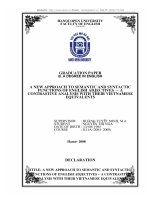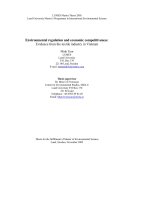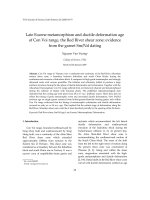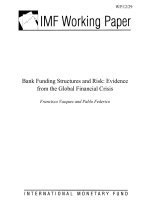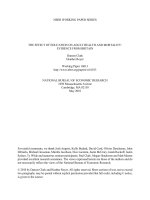Syntactic complexity of EFL, ESL and ENL evidence from the international corpus network of asian learners of english
Bạn đang xem bản rút gọn của tài liệu. Xem và tải ngay bản đầy đủ của tài liệu tại đây (1.27 MB, 135 trang )
SYNTACTIC COMPLEXITY OF EFL, ESL AND ENL:
EVIDENCE FROM THE INTERNATIONAL CORPUS
NETWORK OF ASIAN LEARNERS OF ENGLISH
DONG QI
(M.A.), GDUFS
A THESIS SUBMITTED
FOR THE DEGREE OF MASTER OF ARTS
DEPARTMENT OF ENGLISH LANGUAGE AND LITERATURE
NATIONAL UNIVERSITY OF SINGAPORE
2014
DECLARATION
I hereby declare that this thesis is my original work and it has been
written by me in its entirety.
I have duly acknowledged all the sources of information which have
been used in the thesis.
This thesis has also not been submitted for any degree in any
university previously
______________________
ACKNOWLEDGEMENTS
My gratitude goes to a number of people who have helped me in the
completion of this thesis.
First of all, I would like to thank my supervisor, Associate Professor
Vincent B Y Ooi from National University of Singapore who provided
constant guidance, advice and support throughout my entire program.
Without his help, this study would never have been completed.
I am also grateful for the two anonymous reviewers who have offered
detailed and thought-provoking suggestions for revision. Besides, in the
early stage of drafting, Professor Bao Zhiming and Dr. Justina Ong from
National University of Singapore offered invaluable comments. Professor
Lourdes Ortega from Georgetown University and Professor Yukio Tono from
Tokyo University of Foreign Studies also provided help one way or another
for my work.
During the data collection, Dr. Yosuke Sato, Dr Chonghyuck Kim
and my classmates Lim Ching Geck and Nattadaporn Lertcheva also helped
me enrol research participants, for which I am always thankful.
Last but not least, I need to express my heartfelt gratitude to my
family members and friends in my home country for their unfailing
encouragement and spiritual support.
ii
TABLE OF CONTENTS
DECLARATION .............................................................................................. i
ACKNOWLEDGEMENTS ............................................................................ii
TABLE OF CONTENTS .............................................................................. iii
SUMMARY .................................................................................................... 1
LIST OF TABLES .......................................................................................... 3
LIST OF FIGURES......................................................................................... 4
LIST OF ABBREVIATIONS.......................................................................... 5
CHAPTER ONE: INTRODUCTION ............................................................. 7
1.1 Introduction ................................................................................... 7
1.2 Thesis organization ....................................................................... 8
1.3 Research motivation ...................................................................... 9
1.3.1 Importance of syntactic complexity ................................... 9
1.3.2 Scarcity of corpus-based studies on sentences ................. 10
1.4 Literature review ......................................................................... 12
1.4.1 Overview of studies on syntactic complexity in L2 study
............................................................................................................... 12
1.4.2 Measures for studying syntactic complexity .................... 14
1.4.3 Reliability of the studies on syntactic complexity ........... 19
1.4.4 Syntactic complexity and proficiency .............................. 20
1.4.5 Automation of syntactic analysis vs. manual annotation . 22
1.5 Syntactic complexity used in this study: A multidimensional
annotation scheme of syntactic complexity .................................................. 23
1.5.1 Introduction of units ......................................................... 23
iii
1.5.2 Global complexity ............................................................ 25
1.5.3 Complexity by subordination ........................................... 25
1.5.4 Complexity by coordination............................................. 26
1.5.5 Phrasal complexity ........................................................... 26
1.5.6 Specific measures of syntactic complexity. ..................... 26
1.5.7 T-unit-based complexity ................................................... 27
1.6 Chapter conclusion ...................................................................... 31
CHAPTER TWO: RESEARCH DESIGN .................................................... 32
2.1 Introduction ................................................................................. 32
2.2 Rationale of the research design ................................................. 33
2.2.1 Contrastive Interlanguage Analysis in learner corpus
research ................................................................................................. 34
2.2.2 Comparison of syntactic complexity of EFL and ESL
learners .................................................................................................. 35
2.3 Scope of measurement ................................................................ 36
2.4 Research questions ...................................................................... 37
2.4.1 Relationship between proficiency level and syntactic
complexity ............................................................................................. 37
2.4.2 Correlation between different syntactic complexity
measures ................................................................................................ 38
2.4.3 Influence of topic on syntactic complexity ...................... 39
2.5 Data construction ........................................................................ 40
2.5.1 Decision on data selection................................................ 40
2.5.2 Introduction to the ICNALE ............................................ 43
iv
2.5.3 Construction of the Singapore ICNALE .......................... 48
2.6 Data annotation ........................................................................... 50
2.6.1 Automatic annotation tool: L2 Syntactic Complexity
Analyzer ................................................................................................ 52
2.6.2 Manual annotation tool: UAM CorpusTool ..................... 53
2.7 Chapter conclusion ...................................................................... 55
CHAPTER THREE: DATA ANALYSIS ...................................................... 56
3.1 Introduction ................................................................................. 56
3.2 Syntactic complexity and proficiency ......................................... 57
3.2.1 Global complexity measures and proficiency .................. 58
3.2.2 Subordination-based complexity measures and proficiency
............................................................................................................... 64
3.2.3 Coordination-based complexity measures and proficiency
............................................................................................................... 67
3.2.4 Phrasal complexity and proficiency ................................. 69
3.2.5 Specific complexity measures and proficiency ................ 72
3.2.6 T-unit-related measures for syntactic complexity ............ 75
3.3 Correlation between syntactic complexity measures .................. 78
3.3.1 Subordination-based and global syntactic complexity
measures ................................................................................................ 78
3.3.2 Coordination-based and global syntactic complexity
measures ................................................................................................ 79
3.3.3 Phrasal, global and subordination-based complexity
measures ................................................................................................ 80
v
3.3.4 Measures related to mean length of clauses ..................... 82
3.4 Effect of topic on syntactic complexity ...................................... 83
3.4.1 General comparison of syntactic complexity in two topics
............................................................................................................... 84
3.4.2 Influence of topic on mean length of sentences ............... 87
3.4.3 Influence of topic on subordination and coordination ..... 87
3.4.4 Impact of topic on phrasal complexity ............................. 90
3.4.5 Influence of topic on specific complexity measures ........ 91
3.5 Chapter Conclusion ..................................................................... 93
CHAPTER FOUR:
DATA DISCUSSION ................................................. 95
4.1 Introduction ................................................................................. 95
4.2 Syntactic complexity and proficiency ......................................... 95
4.2.1 Measures serving as positive indicators of proficiency ... 95
4.2.2 Measures serving as weak indicators of proficiency ....... 99
4.2.3 Methodological implications.......................................... 102
4.2.4 Pedagogical implications ............................................... 104
4.3 Correlation between syntactic complexity measures ................ 105
4.4 Topic effect on syntactic complexity ........................................ 106
4.5 Chapter conclusion .................................................................... 108
CHAPTER FIVE: CONCLUSION ............................................................. 110
5.1 Reflection on research findings................................................. 110
5.2 Limitations and future directions .............................................. 111
BIBLIOGRAPHY ....................................................................................... 114
vi
SUMMARY
In response to calls for more corpus-based studies at the syntactic
level, this study is an attempt to further extend the scope of learner corpus
research by investigating the syntactic complexity of EFL, ESL and ENL
exemplified by the International Corpus Network of Asian Learners of
English (ICNALE). Specifically, based on certain syntactic complexity
measures, this study intends to reveal how the language proficiency of the
three groups is related to the syntactic complexity measures as shown in
their writing, how those measures correlate to each other and how topics
influence the syntactic complexity. Three sub-corpora of the ICNALE are
employed as the research data, representing the three varietal types
respectively. The ICNALE features the strict control over variables such as
time, topic and proficiency level, ensuring the maximum reliability of
comparison. Data used in this study is both automatically and manually
annotated with a detailed multidimensional annotation scheme of syntactic
complexity features, aiming to reveal the syntactic information which is
unsearchable from raw corpora.
Research findings suggest that global complexity measures and
subordination-based complexity measures seem to be stable indicators of
proficiency levels. Syntactic complexity features within a certain group are
relatively stable, regardless of their proficiency levels. Coordination-based,
phrasal and specific complexity measures divided by sentences rather than
clauses are generally better indicators of proficiency. T-unit-based measures
are disputable in signalling proficiency levels. Correlations between certain
measures are also established and explained tentatively. As for the effect of
1
topic, there seems to be a higher level of syntactic complexity for topic
“part-time job” in terms of most measures, supporting the argument that
certain topics can induce more complex sentences.
The significance of this study lies in its contribution to revealing the
certain features of syntactic complexity of the three groups, which are
seldom systematically studied in previous literature due to the lack of strictly
controlled corpora. Moreover, based on a relatively detailed annotation
scheme, this study also takes the influence of multiple issues like proficiency
levels and topic into consideration and offers a clearer picture of how those
issues interact with the syntactic complexity across or within the three
groups. The research findings might shed light on the following aspects:
methodologically, this study illustrates how to use annotated learner corpora
to examine the syntactic complexity tentatively; pedagogically, teaching
methods and material might be improved accordingly to help learners to
approximate native writers in terms of syntactic complexity.
2
LIST OF TABLES
Table 1 Selected measures for examining syntactic complexity in the past ten
years (2004-2013) ........................................................................... 18
Table 2 Syntactic complexity measures used in the study ............................ 29
Table 3 Comparison of the ICNALE and the ICLE ...................................... 47
Table 4 Composition of corpora in the study ................................................ 48
Table 5 System-annotator agreement between manual annotation and
software annotation on random samples ......................................... 52
Table 6 Global complexity measures of EFL, ESL and ENL ....................... 59
Table 7 Coordination-based complexity measures of EFL, ESL and ENL .. 68
Table 8 CN/S of EFL, ESL and ENL ............................................................ 72
Table 9 T-Unit-related measures for syntactic complexity ........................... 76
Table 10 Pearson’s correlation between subordination-based and general
syntactic complexity measures........................................................ 79
Table 11 Pearson’s correlation between coordination-based and general
syntactic complexity measures........................................................ 80
Table
12 Pearson’s correlation between phrasal and global/
subordination-based syntactic complexity measures ...................... 82
Table 13 Pearson’s correlation between MLC and other measures .............. 83
Table 14 Topic effect on the whole data and each group .............................. 86
3
LIST OF FIGURES
Figure 1 Contrastive Interlanguage Model ................................................... 34
Figure 2 Cline of proficiency in EFL, ESL and ENL ................................... 58
Figure 3 MLS of EFL, ESL and ENL ........................................................... 61
Figure 4 MLS of proficiency level B1_2 in EFL and ESL ........................... 62
Figure 5 C/S of EFL, ESL and ENL ............................................................. 63
Figure 6 C/S of proficiency level B1_2 in EFL and ESL ............................. 64
Figure 7 DC/C and DC/S of EFL, ESL and ENL ......................................... 65
Figure 8 DC/S of EFL, ESL and ENL .......................................................... 67
Figure 9 DC/S of proficiency level B1_2 of EFL and ESL .......................... 67
Figure 10 CP/S of proficiency B1_2 in EFL, ESL and ENL ........................ 69
Figure 11 MLC of EFL, ESL and ENL ......................................................... 70
Figure 12 CN/S of EFL, ESL and ENL ........................................................ 71
Figure 13 B/C and B/S in EFL, ESL and ENL ............................................. 73
Figure 14 Typical use of be-copula by EFL learners .................................... 74
Figure 15 I/C and I/S in EFL, ESL and ENL ................................................ 75
Figure 16 Topic effect on mean length of sentences ..................................... 87
Figure 17 Topic effect on subordination by ENL ......................................... 88
Figure 18 Topic effect on coordination ......................................................... 89
Figure 19 Topic effect on MLC..................................................................... 90
Figure 20 Topic effect on CN/C .................................................................... 91
Figure 21 Topic effect on CN/S .................................................................... 91
Figure 22 Topic effect on B/C ....................................................................... 92
Figure 23 Topic effect on B/S ....................................................................... 93
4
LIST OF ABBREVIATIONS
A2_0:
Waystage
B1_1:
Threshold: Lower
B1_2:
Threshold: Upper
B2_0
Vantage or higher
B/C:
Be-copula with Adjective Structures per Clause
B/S:
Be-copula with Adjective Structures per Sentence
CEFR:
The Common European Framework for Reference
CIA:
Contrastive Interlanguage Analysis
CN/C:
Complex Nominals per Clause
CN/S:
Complex Nominals per Sentence
CN/T:
Complex Nominals per T-unit
CP/C:
Coordinate Phrases per Clause
CP/S:
Coordinate Phrases per Sentence
CP/T
Coordinate Phrases per T-unit
C/S:
Clauses per Sentence
C/T:
Clauses per T-unit
CT/T:
Complex T-unit per T-unit
DC/C:
Dependent Clauses per Clause
DC/S:
Dependent Clauses per Sentence
DC/T:
Dependent Clauses per T-unit
EFL:
English as a Foreign Language
ENL:
English as a Native Language
ESL:
English as a Second Language
I/C:
It-cleft Structures per Clause
5
ICE:
The International Corpus of English
ICLE:
The International Corpus of Learner English
ICNALE: The International Corpus Network of Asian Learners of
English
IRB:
The Institutional Review Board
I/S:
It-cleft Structures per Sentence
MLC:
Mean Length of Clauses
MLS:
Mean Length of Sentences
MLT:
Mean Length of T-units
POS:
Part of Speech
T/S:
T-unit per Sentence
VP/T:
Verb Phrases per T-unit
VST:
Vocabulary Size Test
6
CHAPTER ONE: INTRODUCTION
1.1 Introduction
Syntactic complexity, which is also referred to as “syntactic maturity”
or “linguistic complexity”, is identified as greater variety of sentence
patterns, or progressively more elaborate language (Foster & Skehan, 1996,
p. 303). Given its importance and difficulty, syntactic complexity has been
extensively studied in the field of second language acquisition (SLA) and
first language acquisition in the past decades. In corpus linguistics, it was not
until the early 1990s that some corpus linguists tentatively studied learners’
syntactic patterns with a heavy reliance on SLA theories and practices.
Notably, in corpus linguistics, much has been published on lexical issues of
language, covering a wide range of research topics in various backgrounds.
As pointed out by some linguists (e.g. Granger, 2009; Tono, 2010), however,
there is a relative lack of attention on the syntactic information of language
production in corpus linguistics, partially due to the difficulty of extracting
such information from corpora (Gilquin, 2003). Such a scarcity is especially
true when it comes to corpus-based comparison of EFL learners, ESL
learners and ENL learners: most existing studies only focus on the language
production by a certain language group or two groups. Moreover, among
those corpus-based studies on language production at sentence level, it is not
difficult to spot some limitations in certain aspects such as the selection of
corpora and measures for analysis. Further corpus-based studies on syntactic
complexity of the three groups based on comparable datasets are necessary
in this regard.
7
Based on three highly comparable sub-corpora from the ICNALE
(Ishikawa, 2011), this study intends to explore how syntactic complexity is
related to the proficiency of EFL, ESL and ENL, how certain syntactic
complexity measures correlate with others and how topic influences
syntactic complexity. During the construction of various components of the
ICNALE, writing conditions such as time constraints, topics and availability
of references were strictly controlled, making those sub-corpora as
homogenous and comparable as possible. Besides, for those EFL and ENL
components, different proficiency levels are assigned with a unified
framework called the Common European Framework of Reference (CEFR)
(Little, 2007), providing a strong support for establishing the link of
proficiency and certain syntactic complexity measures. Meanwhile, for the
native writer component, both novice native writers and expert native writers
are evenly distributed and identified, taking the influence of writing
expertise on syntactic complexity into consideration. All corpus data used in
this study is annotated with a detailed multidimensional scheme of syntactic
complexity features, making in-depth analysis and comparisons possible.
1.2 Thesis organization
Consistent with the research objectives, this thesis is organized as
follows: Chapter one outlines the research topic and motivation for the study
before offering the background of this research and syntactic complexity
measures used in this study, pointing out how the existing studies can be
improved or extended and affirming the necessity of this research. Based on
the implications drawn from chapter one, the second chapter deals with the
research design, in which the rationale of the design, research questions and
8
data construction/annotation are detailed. In the third chapter, the data
analysis is presented to demonstrate the findings of this research and answer
each research question, followed by a discussion of those findings in chapter
four. The last chapter concludes the thesis and points out the research
directions for further research.
1.3 Research motivation
1.3.1 Importance of syntactic complexity
Being able to employ various sentence patterns is an indispensable
writing skill for successful writers. This issue is often translated into the
syntactic complexity of writing. Syntactic complexity has been long
observed by many linguists and language teachers, who have paid special
attention to the contribution of those more complex sentence patterns in
expressing complex ideas and improving writing quality. It is acknowledged
that “certain syntactic structures, such as subordinate clauses, relative
clauses, and complex noun phrases allow writers to express more complex
ideas” (Beers & Nagy, 2011, p. 184). In this respect, using complex sentence
patterns is necessary for clearly stating one’s ideas effectively. In addition,
the use of complex grammatical structures signals effective writing (de Haan
& van Esch, 2006; Reilly, Zamora, & McGivern, 2005; Rimmer, 2008;
Schleppegrell, 2004). Complex sentence structures are thus related to the
quality of writing in this connection.
On the contrary, simple sentences are often regarded to show the
weakness of learners. Many linguists and educators regard them an
important disadvantage in writing and argue that they may result in the
deduction of writing scores (e.g. Davidson, 1991; Hamp-Lyons, 1991; Reid,
9
1993; Vaughan, 1991). Among many others, Hinkel (2003) conducted a
qualitative analysis of writing by over 1000 learners and native speakers,
noticing that those learners employed excessively simple syntactic
constructions. Such a heavy reliance on simple sentence patterns and
difficulty of using more complex sentence patterns may be attributable to the
current mainstream teaching method in writing instructions. According to
Connors (2000), recent writing instructions tend to focus on some higher
level stages of writing process such as planning and revising, and
consequently the ‘syntax of writing’ is given less attention. Clearly, variation
of different sentence patterns, especially the employment of more complex
sentence patterns, is critical for good writings when it comes to English
learners, who may have difficulty in using various English sentence patterns
at ease.
1.3.2 Scarcity of corpus-based studies on sentences
Despite the importance and difficulty of using more complex
sentences for learners, studies at sentence level in corpus linguistics are less
common compared with those studies on lexical issues, not to mention
studies on the syntactic complexity. It seems that syntactic complexity is
generally examined in SLA research instead. In SLA research where learner
corpora have gradually gained popularity, syntactic complexity is more often
than not explored without the use of corpora. Most of those SLA studies are
based on experiments, tapping the production of learners’ writing (e.g. Foster
& Skehan, 1996). Those experiments generally provide three major types of
data: “Language use data, metalingual judgments and self-report data” (Ellis,
1994, p. 670). The difficulty of drawing firm conclusions from a narrow
10
empirical basis is underlined by many SLA and corpus linguists. Among
others, Gass and Selinker (2008, p. 55) argue that it is “difficult to know
with any degree of certainty whether the results obtained are applicable only
to the one or two learners studied, or whether they are indeed characteristic
of a wide range of subjects”. Learner corpus research features “a wider
empirical basis than has ever previously been available” (Granger & Paquot,
2009, p. 16) is thus adopted to study the syntactic complexity in this
research.
Acknowledging the advantage of learner corpus research over
traditional SLA research in providing a wider range of empirical basis,
linguists also need to note that the potential of learner corpora to study the
syntactic complexity of learners has not yet been fully realized. The scarcity
of corpus-based studies on sentence patterns is largely because of the
difficulty of extracting such information with appropriate corpora/tools
(Gilquin, 2003). Moreover, “the background of corpus research largely
rooted in the European tradition of descriptive and functional linguistics”
(Tono, 2010, p. 9) also contributes to this scarcity. On one hand, querying of
raw corpora is still limited to the search of lexical information. Obviously,
words are easier to count and classify than sentence structures (Rimmer,
2008). Although certain parsed corpora can be used to study certain
characteristics of sentence patterns, they are not always available to the
public. On the other hand, while various computational tools for analysing
corpus have been devised globally in the past decades, most of them are
seldom used to examine the syntactic features, except for a few of them such
as Hawkins and Buttery (2010), Lu (2010) and Saville (2010).
11
The scarcity of corpus-based studies on sentences is especially true in
the comparison of EFL, ESL and ENL in a single study. Among them,
studies on the use of sentences by ESL learners such as Singapore English
learners are also not very common. Undeniably, language acquisition in
Singapore with a context of complex multilingual settings deserves special
attention (Kirkpatrick, 2011). As noted by Schneider (2007: 157), the syntax
of Singapore English features many distinctive rules and patterns; however,
they are seldom systematically examined based on learner data. Among
those existing studies where syntactic features of Singapore English are
discussed, we may still find relatively small datasets by researchers with a
tendency to emphasize colloquial Singapore English (e.g. Deterding, 2010;
Low & Brown, 2005) rather than the type of 'standard' Singapore English
described by Low (2010), not to mention the written English used by
Singapore English learners. Given the scarcity of corpus-based studies on
sentences, especially the comparison of EFL, ESL and ENL in a single study,
the current research aims to bridge this gap by conducting a corpus-based
project to examine the syntactic complexity of writings by EFL learner, ESL
learners (Singapore English learners here) and ENL writers.
1.4 Literature review
1.4.1 Overview of studies on syntactic complexity in L2 study
Syntactic complexity, as the major approach to study sentence
variation, has been explored in a wide range of areas in applied linguistics
including first language acquisition, language disorder studies and SLA
research. As for its applications in SLA research, existing studies can be
grouped into the following categories: First, syntactic complexity often
12
refers to evaluating the impact of different experiment settings on language
production, for instance, the impact of planning time on language production
(Foster & Skehan, 1996). Besides, syntactic complexity is also applied to
study the variation of language production across language groups, for
example, the language production of eight learner groups with different first
language (Taguchi, Crawford, & Wetzel, 2013). Third, syntactic complexity
has also been applied to map the proficiency levels within certain learner
groups, for instance, the study of the relationship between Chinese English
learners’ language proficiency and syntactic complexity measures (Lu,
2011).
Generally, syntactic complexity has been explored through the
calculation of the average length of certain syntactic units, density of
subordination and frequency of certain linguistically more complex forms
(Ortega, 2012). Wolfe-Quintero, Inagaki, and Kim (1998) and Ortega (2003)
offer two research syntheses of studies on syntactic complexity, in which
various existing studies are compared and evaluated. Notably, subsequent
studies on syntactic complexity have seldom been systematically reviewed
and compared. In what follows, some representative newer studies on
syntactic complexity are thus reviewed with an emphasis on four critical
issues related to the study: 1). measures for studying L2 syntactic complexity;
2) reliability of those measures; 3). the relationship between L2 proficiency
level and syntactic complexity; and 4) the automatic analysis of L2 syntactic
complexity and manual annotation.
13
1.4.2 Measures for studying syntactic complexity
A number of representative measures for syntactic complexity are
summarized in Table 1. Consistent with the scope of this research, only those
measures used for L2 writing studies are included. Despite the advances of
knowledge on syntactic complexity, those measures for examining syntactic
complexity do not really change much compared with those used in the past
decades, except for the integration of some specific forms as measures for
syntactic complexity. Regarding the selection of those measures, two points
merit discussion here: the first is on the persistence of T-unit-based measures
in those studies and the second is on the integration of new measures.
Among those measures illustrated in Table 1, measures with T-unit
calculated have gained popularity among existing studies since several
decades ago. Such popularity is especially true for the mean length of T-units,
which is used as the most widespread measure for syntactic complexity (e.g.
Armstrong, 2010; Brown, Iwashita, & McNamara, 2005; Larsen-Freeman,
2006; Nelson & Van Meter, 2007). T-unit, the minimal terminable unit, was
first proposed by Hunt (1965), who defined it as “one main clause plus any
subordinate clause or non-clausal structure that is attached to or embedded in
it’’ (Hunt, 1970, p. 4). Hunt (ibid) argued that mean length of T-units and
clauses per T-unit, together with words per clause were the three most
reliable indicators of syntactic complexity. After that, this argument has been
supported by the overwhelming majority of researchers in the follow
decades. In the two early research syntheses on syntactic complexity by
Wolfe-Quintero et al. (1998) and Ortega (2003), they agree on that this
measure serves as the most reliable measure for discriminating proficiency
14
levels based on their review of over 40 studies in total. Even in some new
studies, mean length of T-unit is still used as the major measure for
discriminating syntactic complexity.
Although T-unit is widely applied in various studies on sentence
complexity in the past decades, its plausibility is questioned by some
linguists (e.g. Bardovi-Harlig, 1992; Biber, Gray, & Poonpon, 2011; Foster
& Skehan, 1996; Gaies, 1980; Lu, 2011). Their criticism can be grouped into
the following categories. First, by “imposing uniformity of length and
complexity on output that is not present in the original language sample”
(Bardovi-Harlig, 1992, p. 391), T-unit may distort the original intentions of
language learners who produce sentences rather than T-units. Second, a
T-unit analysis ignores some useful information such as the coordination
(Ortega, 2012) and noun clausal features embedded in noun phrases (Biber
et al., 2011), both of which are also important indicators of syntactic
complexity for certain group of learners. Third, some empirical studies have
found that T-unit measures are not always capable of differentiating syntactic
complexity because those more proficient learners are not necessarily those
who produce longer T-units in (e.g. Smart & Crawford, 2009). It is also
noted that there is not any theoretical rationale for the use of T-unit.
Apart from the first two categories of measures, the third category of
measures which features the specific forms of language production seems to
be neglected by most researchers in their studies of syntactic complexity.
Knowing the length of production of unit and subordination does not
necessitate a full understanding of syntactic complexity because the first two
categories of measures can only provide certain quantitative information
15
which is not so helpful for making specific inferences or judgments. In
certain cases, following measures from the first two categories without
careful consideration may result in the misinterpretation of data. Length does
not necessarily increase as those learners progress to more advanced levels.
It is possible for more advanced learners to produce longer T-units, however,
such an increase can be a result of increased use of complex phrases such as
coordinate phrases and complex nominals, rather than increased use of
subordination (Lu, 2010). Likewise, advanced learners may also choose to
use more embedding rather than longer syntactic structures, resulting in
shorter production units (Arthur, 1979; Kern & Schultz, 1992). In this regard,
other more specific measures are needed to complement the length-based
measures and subordination-based measures.
Complementing or extending the first two mainstream categories of
measures, other types of measures targeting at certain characteristics of
syntactic complexity are of great importance given the possible limitations
of the first two categories. The integration of some other types of forms to
measures for syntactic complexity may help researchers further reveal
certain characteristics of syntactic complexity (e.g. Lu, 2011; Vyatkina,
2013). Notably, the integration of those forms has its empirical support in
some L2 studies. For instance, features such as phrasal features and complex
nominals can further contribute to the in-depth exploration of syntactic
complexity. Phrasal features are found to index writing quality and are thus
recommended to be incorporated into the measure for syntactic complexity
(Biber & Gray, 2010; Biber et al., 2011; McNamara, Crossley, & McCarthy,
2010; Rimmer, 2006). Complex nominals often serve as an alternative to
16
relative clauses (Hundt, Denison, & Schneider, 2012) and may also reflect
the complexity of sentences (Gordon, Hendrick, & Johnson, 2004; Halliday,
1989; Halliday & Webster, 2004). In a comparison of syntactic complexity
features of academic writing and spoken language, Biber et al. (2011) find
that “complex nominals (rather than clause constituents) and complex
phrases (rather than clauses) are common in academic writing”, both of
which are generally considered to be less grammatically complex. Such an
observation refutes the assumption that more subordination structures equal
more grammatically complex sentences, which makes those syntactic
complexity studies purely based on subordination-related measures
self-contradictory.
Those measures featuring certain forms of syntactic complexity are
certainly not limited to those mentioned in Table 1. Extension or further
justification of them in future research is still necessary since those measures
related to phrasal complexity and complex nominals are still relative new in
the research into syntactic complexity. Compared with length-based
measures and subordination-based measures, those measures are relatively
less frequent in previous studies. They are more specific compared with the
complexity measures based on lengths of certain units or subordination
structures. As observed by some linguists, the more specific a measure is, the
more revealing it is (Hudson, 2009). Notably, while length-based measures
and subordination-based measures have long enjoyed popularity in syntactic
complexity research, those specific complexity measures also begin to gain
popularity in some latest studies, which may help us gain a clearer picture of
how syntactic complexity is represented and evaluated.
17
Table 1 Selected measures for examining syntactic complexity in the past ten years (2004-2013)
Category of measures
Measures
Sources
Length-based measures
Mean length of sentences
Benedikt Szmrecsanyi (2004)
Mean length of T-units
Armstrong (2010)
Mean length of clauses
Byrnes (2009)
Mean number of clauses per T-unit
Becker (2010)
Mean number of dependent clauses per clauses
Wigglesworth and Storch (2009)
Frequency of dependent clauses
Biber et al. (2011)
Frequency of subordinate conjunction
Vyatkina (2012)
Specific forms of syntactic
Frequency of tenses, modal verbs and voices (passive
Ellis and Yuan (2005)
complexity
forms)
Subordination-based measures
Frequency of coordinate structures, complex nominal
Vyatkina (2013)
structures and non-finite verb structures
Frequency of phrasal features such as Post–
noun-modifying prepositional phrase
18
Taguchi et al. (2013)
